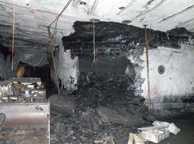Mining Feature: Rib Falls: A Major Ground Control Issue
Wednesday, June 29, 2011
Miners in West Virginia and Kentucky were killed recently when large sections of coal pillar ribs fell on them. These fatal accidents, which occurred in the last week of June, demonstrate that rib falls remain a threat to mineworker safety and are still a major ground control issue.
As mining progresses, the loading on coal mine pillars increases as they support the overburden load previously held up by the recently mined coal. Pillar rib failure, sometimes called a roll, can occur as the edges of the pillar yield under the excessive pressure of the overburden rock weight and cracks or other natural defects cause sections to become detached and fall away.
As part of its mission to eliminate ground failure fatalities and injuries in the mining industry, NIOSH's Office of Mine Safety and Health Research has developed a new project to produce guidance and tools to improve management of rib fall hazards. The proposed research will begin later this year.
The two main factors that create rib fall hazards are mining height and seam depth. Since 1995, nearly 75 percent of fatal rib falls have been at mining heights greater than 7 ft and at depths greater than 700 ft. Further, injury statistics indicate that rib fall injury rates increase with seam height.
During the last five years, the rib fall injury rate in the United States has remained essentially unchanged. The number of fatalities and injuries, the severity of the injuries, and especially the lack of any positive change in the injury rates highlight the need to improve rib hazard management.
How Big is the Problem?
- There have been 13 occupational rib fall fatalities from 2005 through 2009 accounting for 34% of fatal ground falls in underground U.S. coal mines. A rib fall includes falls from a face, rib, pillar, side, or highwall (from in place).
- Approximately 83% of all rib fall injuries were non-fatal lost-time injuries and resulted in an average of 93 lost work days (statutory, actual, and restricted).
Although protecting miners from hazards related to rib falls is addressed in a recent MSHA Public Information Bulletin, current government regulations specify no minimum requirements for rib support. Presently, only a limited number of coal mines in the U.S. support the rib on a routine basis. These are generally longwall mines and those with higher seams. The proposed OMSHR research effort will investigate the mechanics of rib support design to allow engineered systems to be developed and installed. The effort will also produce guidance on when rib support is necessary to ensure miner safety and provide design tools to allow mine operators to develop well-engineered rib support plans.
NIOSH OMSHR links related to Rib Falls
See Also
- Independent Contractor Trends in the United States Mining Industry
- Independent Contractors
- Metal Operator Mining Facts - 2002
- Metal Operator Mining Facts - 2004
- Mining Fact Sheets
- Noncoal Contractor Mining Facts - 2003
- Nonmetal Operator Mining Facts - 2002
- Overall Mining Facts 2008 (HTML)
- Statistics: All Mining
- Stone Operator Mining Facts - 2005
- Page last reviewed: 10/26/2016
- Page last updated: 9/28/2012
- Content source: National Institute for Occupational Safety and Health, Mining Program


 ShareCompartir
ShareCompartir
